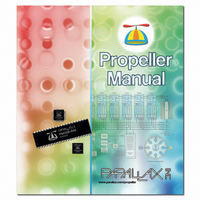122-32000 Parallax Inc, 122-32000 Datasheet - Page 252

122-32000
Manufacturer Part Number
122-32000
Description
MANUAL PROPELLER
Manufacturer
Parallax Inc
Specifications of 122-32000
Accessory Type
Manual
Lead Free Status / RoHS Status
Lead free / RoHS Compliant
For Use With/related Products
Propeller Education (PE) Kit
Lead Free Status / Rohs Status
Lead free / RoHS Compliant
- Current page: 252 of 438
- Download datasheet (5Mb)
Here are assignment operator examples:
Count++
Data >>= 3 ' (Binary) shift Data right 3 bits
Binary operators have special forms that end in equal ‘
Unary operators do not have a special assignment form; some always assign while others
assign only in special situations. See Table 4-9 below and the operator’s explanation, for
more information.
Constant and/or Variable Expression
Operators which have the integer-constant-expression attribute can be used both at run time
in variable expressions, and at compile time in constant expressions. Operators which have
the float-constant-expression attribute can be used in compile-time constant expressions.
Operators without either of the constant-expression attributes can only be used at run time in
variable expressions. Most operators have a normal, non-assignment form that allows them
to be used in both constant and variable expressions.
Level of Precedence
Each operator has an assigned level of precedence that determines when it will take action in
relation to other operators within the same expression. For example, it is commonly known
that Algebraic rules require multiply and divide operations to be performed before add and
subtract operations. The multiply and divide operators are said to have a “higher level of
precedence” than add and subtract. Additionally, multiply and divide are commutable; both
are on the same precedence level, so their operations result in the same value regardless of the
order it is performed (multiply first, then divide, or vice versa). Commutative operators are
always evaluated left to right except where parentheses override that rule.
The Propeller chip applies the order-of-operations rules as does Algebra: expressions are
evaluated left-to-right, except where parentheses and differing levels of precedence exist.
Following these rules, the Propeller will evaluate:
...to be equal to 49; that is, 8 * 4 = 32, 6 / 2 = 3, and 20 + 32 – 3 = 49. If you wish the
expression to be evaluated differently, use parentheses to enclose the necessary portions of
the expression.
Page 252 · Propeller Manual v1.0
X = 20 + 8 * 4 – 6 / 2
' (Unary) evaluate Count + 1
' and write result to Count
' and write result to Data
=
’ to make them assignment operators.
Related parts for 122-32000
Image
Part Number
Description
Manufacturer
Datasheet
Request
R

Part Number:
Description:
MANUAL FOR SUMOBOT
Manufacturer:
Parallax Inc
Datasheet:

Part Number:
Description:
GUIDE STUDENT PROCESS CONTROL
Manufacturer:
Parallax Inc
Datasheet:

Part Number:
Description:
GUIDE STUDENT SMART SENSORS
Manufacturer:
Parallax Inc
Datasheet:

Part Number:
Description:
LEAD WIRES FLYING CABLE III/IV
Manufacturer:
Xilinx Inc
Datasheet:

Part Number:
Description:
BOARD ADAPTER AND FLY LEADS
Manufacturer:
Xilinx Inc
Datasheet:

Part Number:
Description:
PLATFORM CABLE USB II
Manufacturer:
Xilinx Inc
Datasheet:

Part Number:
Description:
KIT STARTER COOLRUNNER-II BUNDLE
Manufacturer:
Xilinx Inc
Datasheet:

Part Number:
Description:
Microcontroller Modules & Accessories DISCONTINUED BY PARALLAX
Manufacturer:
Parallax Inc

Part Number:
Description:
Microcontroller Modules & Accessories DISCONTINUED BY PARALLAX
Manufacturer:
Parallax Inc

Part Number:
Description:
BOOK UNDERSTANDING SIGNALS
Manufacturer:
Parallax Inc
Datasheet:

Part Number:
Description:
BOARD EXPERIMENT+LCD NX-1000
Manufacturer:
Parallax Inc
Datasheet:

Part Number:
Description:
IC MCU 2K FLASH 50MHZ SO-18
Manufacturer:
Parallax Inc
Datasheet:












